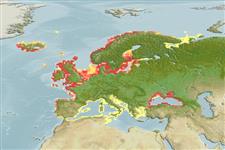Classificação / Names
Common names from other countries
Referência principal
Tamanho / Peso / Idade
Max length : 140 cm SL macho/indeterminado; (Ref. 682); common length : 72.0 cm TL macho/indeterminado; (Ref. 3397); Peso máx. publicado: 50.0 kg (Ref. 682); Idade máx. registada: 38 anos (Ref. 32682)
Length at first maturity
Lm 16.1, range 1 - 600 cm
Ambiente
; marinhas; Água doce; estuarina; anádromos (Ref. 51243); intervalo de profundidade 0 - 28 m (Ref. 101587), usually 1 - 2 m (Ref. 101587)
Clima / Intervalo
Subtropical; 18°C - 24°C (Ref. 12741), preferred 9°C (Ref. 107945); 71°N - 34°N, 25°W - 57°E
Distribuição
Europe and Asia: Atlantic, North, White and Baltic Sea basins, from Spain to Chosha Bay (Russia). Found in Iceland and northernmost rivers of Great Britain and Scandinavia. In Rhône drainage, native only to Lake Geneva basin, which it entered after last glaciation. Native to upper Danube and Volga drainages. Introduced widely. Several countries report adverse ecological impact after introduction.
Países | Áreas FAO | Ecossistemas | Ocorrências | Introduções
Descrição suscinta
Espinhos dorsais (total): 3 - 4; Raios dorsais (total): 10-15; Espinhos anais 3-4; Raios anais : 9 - 14; Vértebras: 57 - 59. Fusiform body (Ref. 51442). Head little and pointed (Ref. 51442). Mouth large, extending mostly after the eye and has well developed teeth (Ref. 51442). Teeth on shaft of vomer numerous and strongly developed (Ref. 7251). Caudal fin with 18-19 rays (Ref. 2196). Caudal peduncle thick and rounded (Ref. 51442). Little scales (Ref. 51442). Body is grey-blue colored with numerous spots, also below the lateral line (Ref. 51442). Blackish colored on upper part of body, usually orange on sides, surrounded by pale halos. Adipose fin with red margin.
Status na Lista Vermelha da IUCN (Ref. 115185)
Perigo para os humanos
Potential pest
Uso pelos humanos
Pescarias: espécies comerciais; Aquacultura: espécies comerciais; peixe esportivo: sim
Ferramentas
Relatórios especiais
Baixar XML
Fontes da internet
Estimates of some properties based on models
Phylogenetic diversity index
PD50 = 0.5000 many relatives (e.g. carps) 0.5 - 2.0 few relatives (e.g. lungfishes)
Nível Trófico
3.4 ±0.1 se; Based on diet studies.
Resiliência
Elevada, tempo mínimo de duplicação da população menor que 15 meses (rm=0.9; K=0.09-0.8; tmax=8; Fec=1,000)
Vulnerabilidade
High vulnerability (60 of 100)
Categoria de preço
